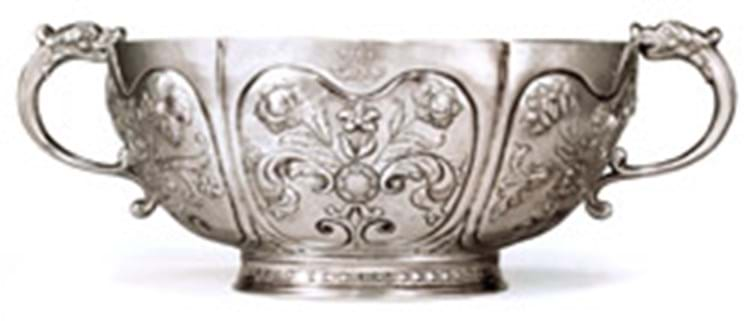
The toast of this year's Americana Week in New York was the spectacular $5.2m (£3.33m) achieved at Sotheby's on January 23 for a New York silver punch bowl c.1700-1710, marked three times for the third-generation Dutch-American Cornelius Kierstede (1674-c.1757). At 66oz and 121/4in (32cm) diameter - 171/4in (44cm) when measuring across the sculptural dolphin handles - it is probably the largest surviving piece of early 18th century American silver. And, it only came to light last year in England.
The original owner of such a massive and valuable piece could only have been a member of the wealthiest levels of Dutch society in New York City or nearby Albany. The list is not a long one and a number of candidates have been suggested, including Colonel Abraham de Peyster, Mayor of New York (1692-94), whose will, probated in 1734, lists a large silver punch bowl of a weight to match this one.
However, it is symptomatic of the shift of wealth in New York society at the turn of the 18th century (by 1720 most of New York's wealthiest residents were English) that relatively early in its life the bowl was owned by Commodore Joshua Loring (1716-81) and his wife Mary Curtis (1720-1789/90). Their stately home in Jamaica Plain, Massachusetts, the Loring-Greenough House, has been preserved as an historic site.
A Loyalist with no stomach for revolution, Loring abandoned his residence in August 1774 to take refuge in Boston, and the family emigrated to London in 1776.
The most tangible evidence of their considerable wealth came with them.
This bowl is accompanied by two 19th century documents, including the revealing note: "Silver bowl belonged to Joshua Loring and was buried in a well during the War of American Independence (the Loring family was then living in America) and brought up when it was over."
But, although in England since 1776, the discovery only came to light when - following an introduction by a colleague in the paintings department - Sotheby's London-based silver specialists Cynthia Harris and Harry Charteris were shown a grainy black and white photograph in March last year. They were invited to inspect the bowl in a London bank vault.
The 230 years away from its native shores had added only a subtle patina to the playful repoussé detail that epitomises the New York Dutch style.
The most comparable piece from Cornelius Kierstede's body of work is the two-handled 'brandywine' bowl in the Metropolitan Museum of Art made for Theunis Jacobsen Quick, a prominent New York baker. However, at under 26oz this bowl - previously considered the largest piece of early 18th century American silver - is less than half the weight of the new discovery.
Sotheby's New York specialists were given the task of coming up with a valuation and plumped for $400,000-800,000, a figure that delighted the vendor but anticipated a new record for American silver to surpass the premium-inclusive $775,750 achieved for a Boston communion cup by John Hull and Robert Sanderson c.1660 from the Church of the Presidents, Quincy, Massachusetts at Sotheby's New York in 2001.
In the event, the record was smashed.
Auctioneer David Redden opened the bidding at $275,000 and almost instantly a bid of $500,000 was called out by Ian Irving of Ian Irving Ltd. As many as six different bidders raised their paddles, but at around $3m the battle was reduced to two determined clients, an anonymous gentleman seated in the room and New York dealer S.J. Shrubsole. The competition continued for several minutes before the winning bid was cast by the anonymous purchaser in the room, the gavel coming down to rousing applause.
The price is the second highest for any piece of silver sold at auction. It is surpassed only by the Louis XV tureen and stand made by Thomas Germain, Paris, 1733-34 sold for a premium-inclusive $10,287,500 at Sotheby's, New York in November 1996.
By Roland Arkell
The buyer's premium at Sotheby's is 25/20/12%




